If you think that the ongoing edition of the Manifesta biennale is not enough to lure you to the Limburg region of Belgium, how about an exhibition about the work of 30 artists who are looking for gaps in the ruling systems and structures?
Mind the System, Find the Gap is this year’s Summer exhibition at Z33 and the concept of the show has been applied literally to the Z33 space. The artworks occupy every space available: they are in the usual exhibition spaces of course but also in the garden, in the reception area, and inside the little Beguinage houses.
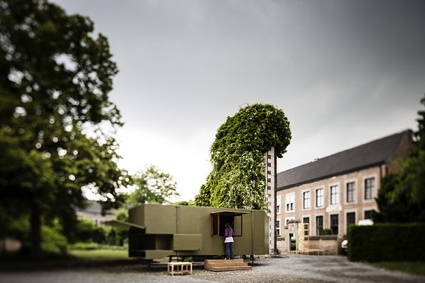 Atelier Van Lieshout, Autocraat (part of Insect Farm), 2012. Photo: Kristof Vrancken / Z33
Atelier Van Lieshout, Autocraat (part of Insect Farm), 2012. Photo: Kristof Vrancken / Z33
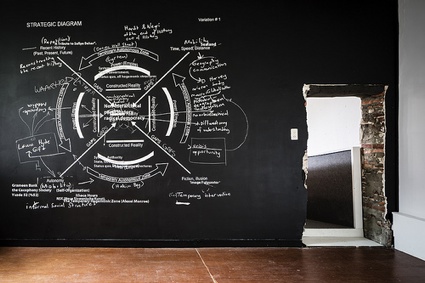 Ahmet Ögüt, Strategic Diagram for Non-hierarchical Participatory Radical Democracy, 2011. Photo: Kristof Vrancken / Z33
Ahmet Ögüt, Strategic Diagram for Non-hierarchical Participatory Radical Democracy, 2011. Photo: Kristof Vrancken / Z33
Our society is governed by all sorts of systems and structures. No system, however, whether political, judicial, economical, socio-cultural or spatial, can comprise life in its entirety. Every system has loopholes, leaks and ambiguities.
The exhibition is uplifting and timely. In these moments of social inequality, austerity, cuts in culture budgets, low social mobility, loss of privacy, recession, it is reassuring to discover that the systems that govern our existences have flaws and spaces that we can infiltrate. Even if this form of resistance is often more symbolic than truly power-challenging.
Some of the participating artists merely reveal and document these gaps while others go further and demonstrate how to take advantage of them. The artworks are organized according to themes: political systems, spatial systems and socio-cultural systems with of course much overlap since many of the artworks confront several systems at the same time.
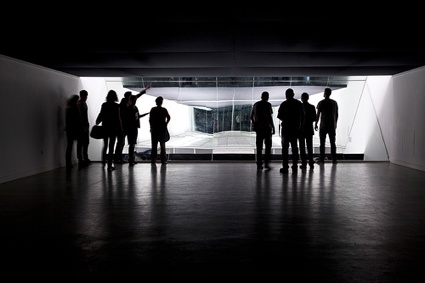 Pablo Valbuena, Re-Flex [Z33], 2012. Photo: Kristof Vrancken / Z33
Pablo Valbuena, Re-Flex [Z33], 2012. Photo: Kristof Vrancken / Z33
The clearest and probably most amusing introduction to the show has to be Matthieu Laurette‘s project. For 8 years, the artist ate, shaved, dressed and showered for free thanks to Moneyback Products, a method of shopping that pushed to the extreme the marketing system of the major food corporations which offer their product with a “Satisfied or your money back” or “Money back on first purchase” label. Similarly, Laurette’s home was always equipped with brand new electrical goods which he sent back before the end of the guarantee – to replace them with brand new ones.
The strategy requires to be extremely well organised. Because most manufacturers ask you to send back a separate till receipts before they will refund items, you need to pay separately for each product.
Moneyback Products was an art project but also a life style that leaked beyond the walls of art galleries. Laurette became indeed a celebrity in the French media, he was invited to popular talk shows and his project appeared on the cover of mainstream magazines.
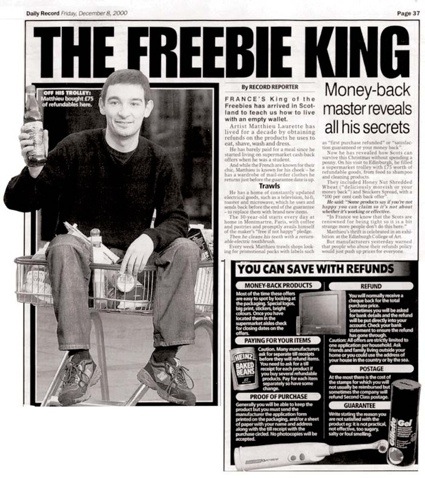 The freebie king, Daily record (UK)(detail), Friday December 8 2000. © Matthieu Laurette
The freebie king, Daily record (UK)(detail), Friday December 8 2000. © Matthieu Laurette
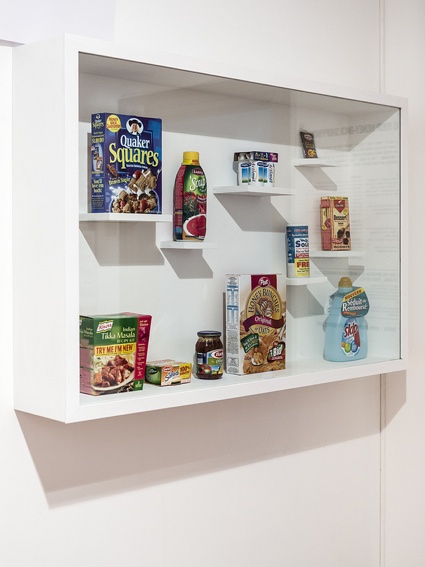 Matthieu Laurette, Mobile Information Stand For Moneyback Products, 1999. Photo: Kristof Vrancken / Z33
Matthieu Laurette, Mobile Information Stand For Moneyback Products, 1999. Photo: Kristof Vrancken / Z33
In Identity4You, Heath Bunting creates off-the-shelf new legal identities built up from a portfolio of unique legal relationships. The work – a continuation of Identity Bureau and the Status Project – draws on the fact that as a human being one can have several legal identities. These identities are constructed through a network of registrations: loyalty cards, bank accounts, phone cards, bills, government correspondence and other person related data. The vaster the network, the stronger the legal identity. Identity4You demonstrates that an identity depends mainly upon administrative systems, rather than personality or even a physical body.
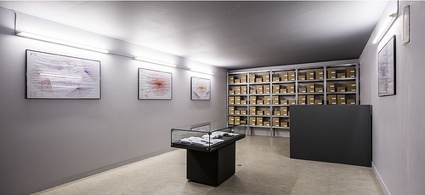
 Heath Bunting, Identity4you, 2012. Photo: Kristof Vrancken / Z33
Heath Bunting, Identity4you, 2012. Photo: Kristof Vrancken / Z33
The animation film What Shall We Do Next is presented as an “archive of gestures to come”. The gestures refer to the patents for the invention of new devices taken out from the USPTO (United States Patent and Trademark Office) from 2006 to 2011. The functioning of upcoming tablets, smartphones, laptops, game consoles, medical instruments and other devices involves gestures that are defined and copyrighted even though the interface does not yet exist. In the video, the artist appropriates the gestures and separates them from their utilitarian function, letting them float in the air and follow a choreographic abstraction.
The work not only explores how technology shapes our behaviour but also questions the privatization of something as basic as a human gesture.
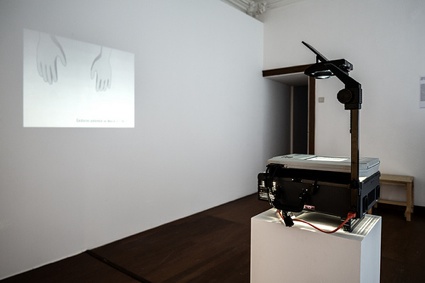 Julien Prévieux, What Shall We Do Next?, 2006-2011. Photo: Kristof Vrancken / Z33
Julien Prévieux, What Shall We Do Next?, 2006-2011. Photo: Kristof Vrancken / Z33
For her performance Bag Lady, Pilvi Takala spent one week in a shopping mall in Berlin, carrying a lot of cash in a transparent plastic bag. As soon as they spotted the content of her bag, sales personnel, security staff, shop owners as well as fellow customers, looked uncomfortable and unsure how to react. Although she behaved like a normal customer, Takala was both a security threat and a subject of protection. This slight intervention sheds controversial light on the fragility of the social order, where private property in the form of money or product is such a holy cow, that it is under constant intuitive public control.
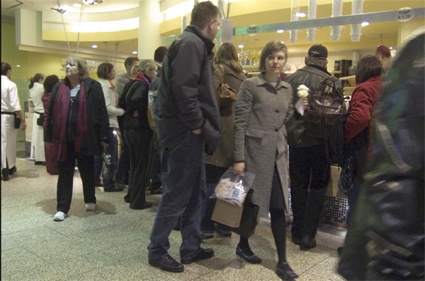 Pivli Takala, Bag Lady, 2006-2008
Pivli Takala, Bag Lady, 2006-2008
We’re getting used to read about architectural works that engages with the cracks in urban space. But we tend to forget that they come from a long tradition of ‘gap exploration.’
In 1973 and 1974, Gordon Matta-Clark purchased, at New York City auctions, fifteen leftover and unwanted properties. Because these properties were too small or too oddly shaped, they were unusable or inaccessible for development. He got each of them for a few dollars.
Matta-Clark documented these urban voids with an archive of deeds, maps, photographs of every inch of his lands, tax receipts, videotapes and other documents. Unfortunately, Matta-Clark died before he could fully realise his plans, and ownership of the properties reverted to the city (the taxes to pay were too expensive.)
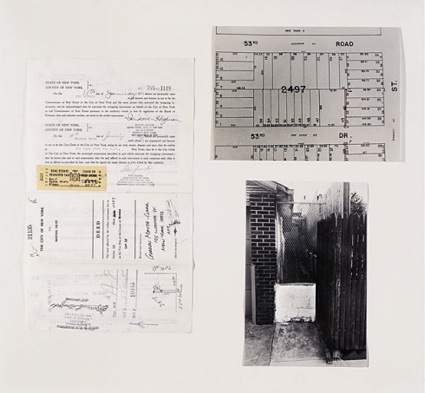 Reality Properties: Fake Estates, Little Alley Block 2497, Lot 42, 1974
Reality Properties: Fake Estates, Little Alley Block 2497, Lot 42, 1974
Dutch architect Anne Holtrop based the design of the Trail House not on gaps but on unofficial use of land. The building structure follows Elephant Paths, the shortcuts that people adopt and trace when they go through meadows, parks or city squares. Over time, the tracing of the Elephant Paths appears on the ground which reinforced the informal route. The architect simply shaped a house to further recognize its existence. Z33 shows the model and Bas Princen’s always impeccable photos.
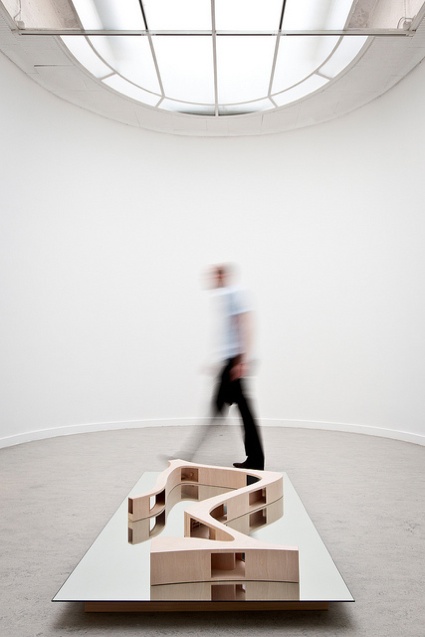 Anne Holtrop, Trail House, 2009. Photo: Kristof Vrancken / Z33
Anne Holtrop, Trail House, 2009. Photo: Kristof Vrancken / Z33
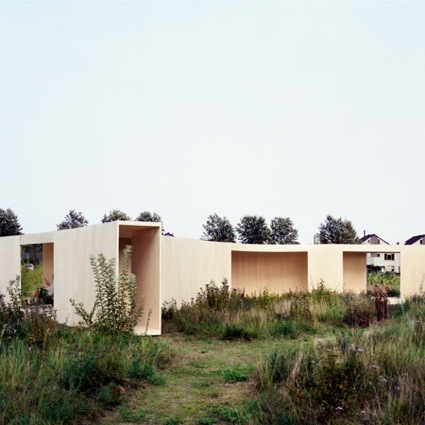 Anne Holtrop, Trail House, 2009. Photo: Bas Princen
Anne Holtrop, Trail House, 2009. Photo: Bas Princen
Tadashi Kawamata‘s Tokyo Project – New Housing Plan explores the possibility to squeeze the home of city dwellers into the overlooked spaces of the Japanese capital: between the fences of construction sites, behind vending machines or even billboards.
Kawamata actually build the houses, each of which was occupied on rotation over a one-week period by the artist and his associates. The inside of the guerrilla houses was surprisingly comfortable with wall-to-wall carpeting, heaters and CD players powered by electricity lifted from external sources such as the vending machines.
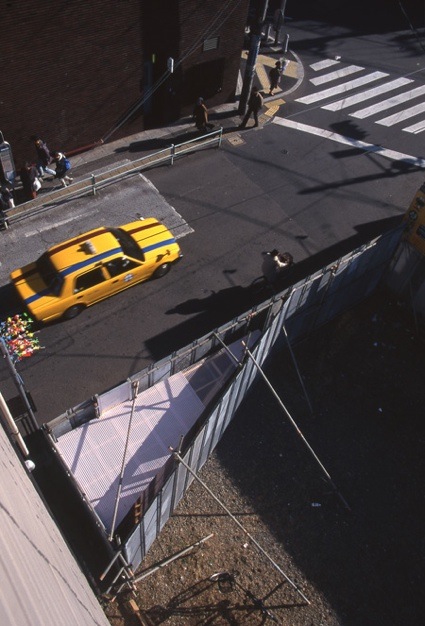 Tadashi Kawamata, Tokyo Project : New Housing Plan, Tokyo, December , 1998, © ANZAÏ
Tadashi Kawamata, Tokyo Project : New Housing Plan, Tokyo, December , 1998, © ANZAÏ
I probably don’t understand fully what makes KALENDER a work that looks for ‘gaps in the system’ but i’m glad i discovered it at Z33.
Between 3 January 2009 and 2 January 2010, Benjamin Verdonck performed more than 150 actions in Antwerp. These actions related to traditional public holidays, the cycle of the seasons, geopolitical shifts and life as it is.
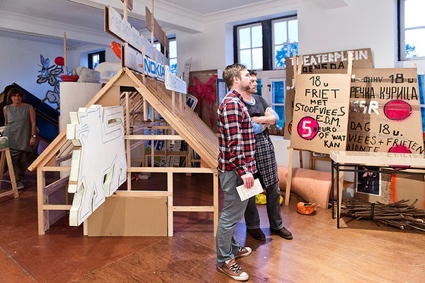 Benjamin Verdonck, Kalender, 2009-2010. Photo: Kristof Vrancken / Z33
Benjamin Verdonck, Kalender, 2009-2010. Photo: Kristof Vrancken / Z33
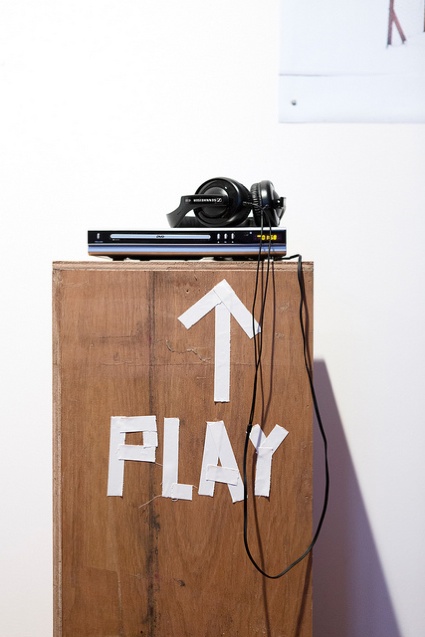 Benjamin Verdonck, Kalender, 2009-2010. Photo: Kristof Vrancken / Z33
Benjamin Verdonck, Kalender, 2009-2010. Photo: Kristof Vrancken / Z33
I particularly like the procession of oversized toilet sanitizer, lighter, mobile phone and soda can.
Benjamin Verdonck, Kalender, Processie der dingen (Procession of Things), 2009
Also in the show:
In ‘Based on a Grid’, Esther Stocker creates a spatial system from a series of black painted wooden blocks in the entrance hall of the Z33 exhibition building. The visitor is drawn into the installation, as it were, and is challenged by the system, the grid that is there but not immediately visible. For Stocker, the system is implied as much by its gaps as it is by its contours. But do we want to look for the system or are we happy to loose ourselves in the chaos of scattered elements drifting apart?
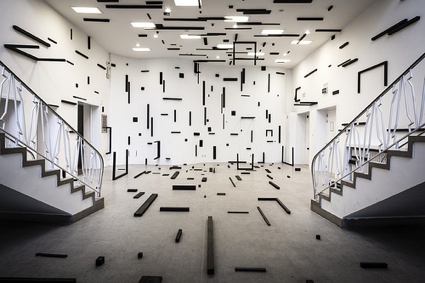 Esther Stocker, Based on a Grid, 2012. Photo: Kristof Vrancken / Z33
Esther Stocker, Based on a Grid, 2012. Photo: Kristof Vrancken / Z33
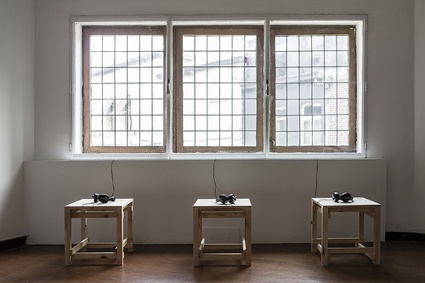 Minouk Lim, International Calling Frequency, 2011. Photo: Kristof Vrancken / Z33
Minouk Lim, International Calling Frequency, 2011. Photo: Kristof Vrancken / Z33
Founded in 1998, Mejor Vida Corp. (Better Life Corporation) is a political and art organization that attempts to level social inequalities by injecting guerrilla art operations into capitalist structures. Mejor Vida Corp. provides free products and services such as international student ID cards, subway tickets for the Mexico City network, recommendation letters, fake barcode stickers to reduce the prices on goods sold by supermarket chains, etc.
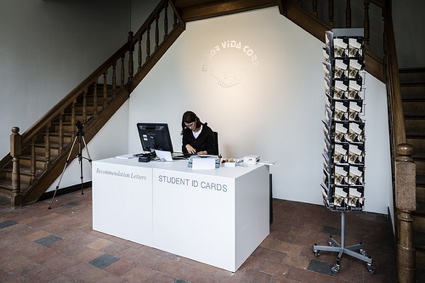 Minerva Cuevas, Mejor Vida Corp. (Better Life Corporation), 1998-. Photo: Kristof Vrancken / Z33
Minerva Cuevas, Mejor Vida Corp. (Better Life Corporation), 1998-. Photo: Kristof Vrancken / Z33
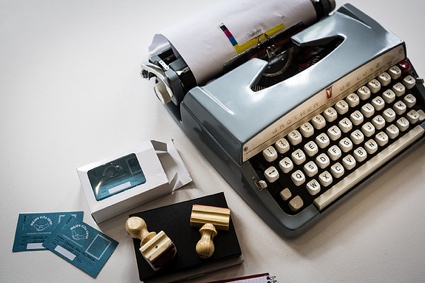 Minerva Cuevas, Mejor Vida Corp. (Better Life Corporation), 1998-. Photo: Kristof Vrancken / Z33
Minerva Cuevas, Mejor Vida Corp. (Better Life Corporation), 1998-. Photo: Kristof Vrancken / Z33
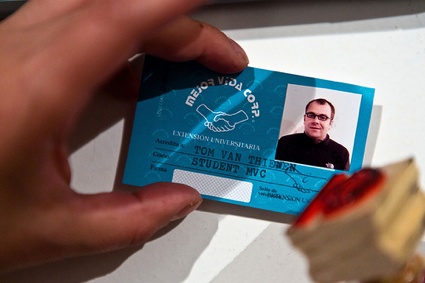 Minerva Cuevas, Mejor Vida Corp. (Better Life Corporation), 1998-. Photo: Kristof Vrancken / Z33
Minerva Cuevas, Mejor Vida Corp. (Better Life Corporation), 1998-. Photo: Kristof Vrancken / Z33
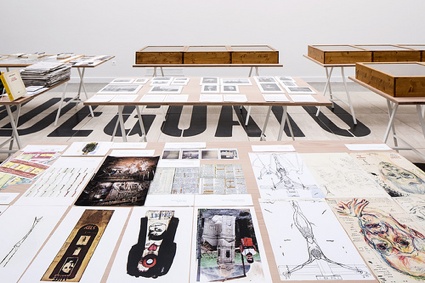 Dora García, The Inadequate, 2012. Photo: Kristof Vrancken / Z33
Dora García, The Inadequate, 2012. Photo: Kristof Vrancken / Z33
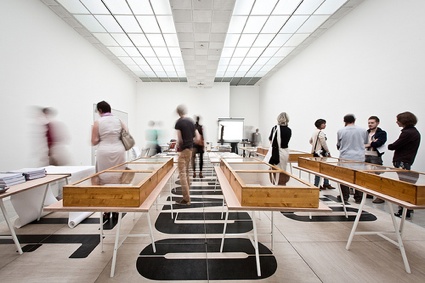 Dora García, The Inadequate, 2012. Photo: Kristof Vrancken / Z33
Dora García, The Inadequate, 2012. Photo: Kristof Vrancken / Z33
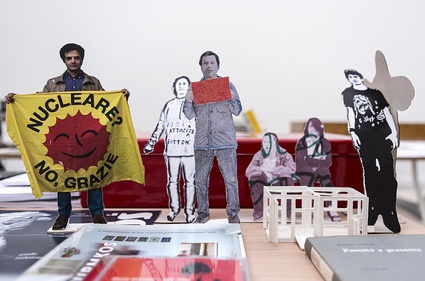 Dora García, The Inadequate, 2012. Photo: Kristof Vrancken / Z33
Dora García, The Inadequate, 2012. Photo: Kristof Vrancken / Z33
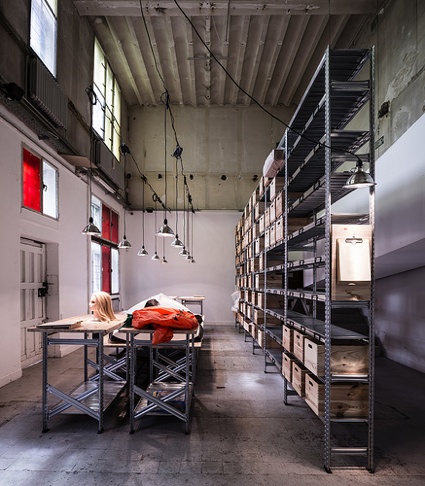 Agency, Verzameling / Assembly, 2012 (Commissioned for Mind the System, Find the Gap). Photo: Kristof Vrancken / Z33
Agency, Verzameling / Assembly, 2012 (Commissioned for Mind the System, Find the Gap). Photo: Kristof Vrancken / Z33
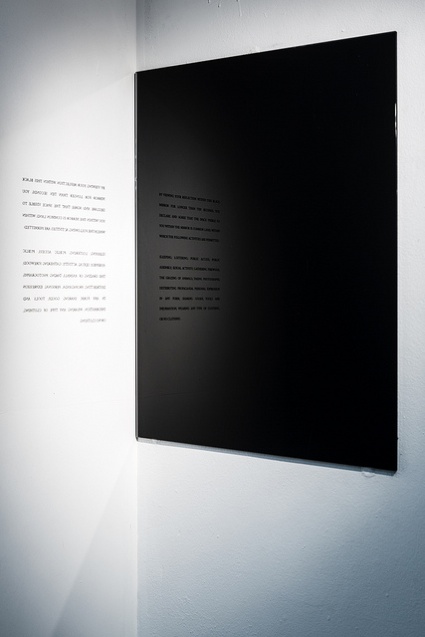 Carey Young, Obsidian Contract, 2010. Photo: Kristof Vrancken / Z33
Carey Young, Obsidian Contract, 2010. Photo: Kristof Vrancken / Z33
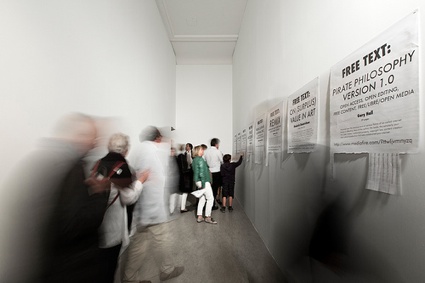 Stephanie Syjuco, Free Texts, 2012. Photo: Kristof Vrancken / Z33
Stephanie Syjuco, Free Texts, 2012. Photo: Kristof Vrancken / Z33
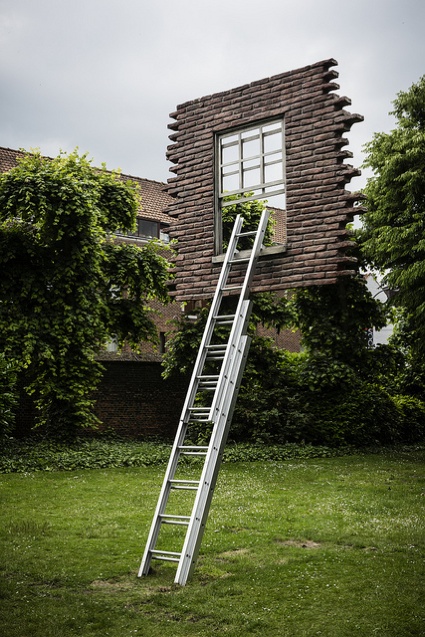 Leandro Erlich, Window and Ladder Too Late For Help, 2008. Photo: Kristof Vrancken / Z33
Leandro Erlich, Window and Ladder Too Late For Help, 2008. Photo: Kristof Vrancken / Z33
Z33 has youtubed a series of introductions to the show as well as some interviews with artists participating to it. I’d recommend the one with Benjamin Verdonck because his accent is so lovely.
Z33’s flickr set. My questionable flickr set.
Mind the System, Find the Gap is a free exhibition and it is open at Z33 in Hasselt until 30 September 2012.
Previously: Mind the System, Find the Sukima (gap).
Identity Bureau, transferable synthetic British natural person.
